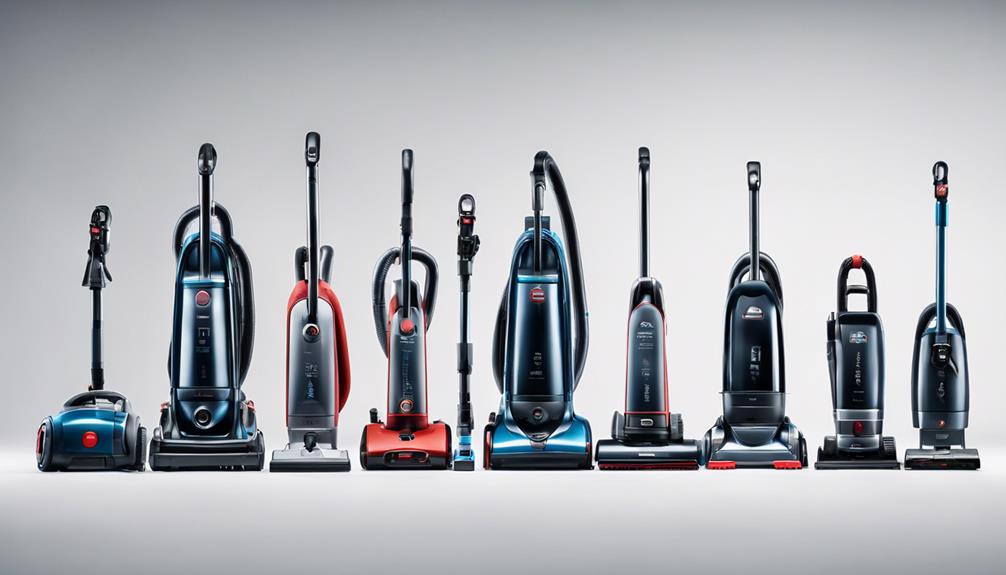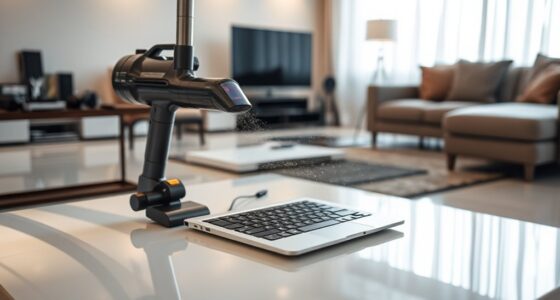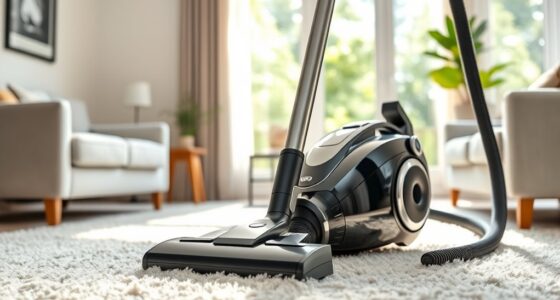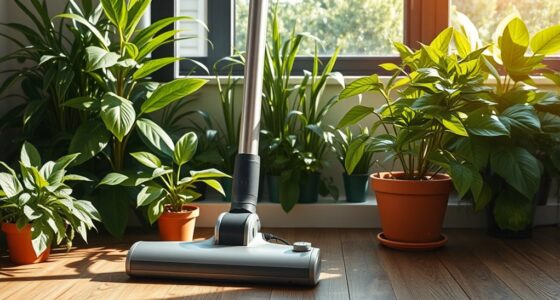Your vacuum might not be effective against allergens because it could be releasing particles back into the air. If it doesn’t have a HEPA filter, up to 50% of dust could escape. Poor maintenance can also hinder performance, allowing allergens to proliferate. For better results, make certain your vacuum has a HEPA filter, keep it clean, and consider a bagged model for better dust containment. Curious about more ways to improve your vacuum’s allergy-fighting capabilities?
Key Takeaways
- Older vacuums may release allergens back into the air; consider upgrading to a model with a HEPA filter for better allergen capture.
- Vacuums without HEPA filters can allow up to 50% of particles to escape, worsening indoor air quality.
- Regular maintenance, including filter replacement every 6-12 months, is essential for effective allergen capture and vacuum performance.
- Bagless vacuums can create dust clouds when emptied; consider using bagged options for superior allergen containment.
- Ensure brush bars are clean and in good condition, as clogged brushes reduce suction and can release trapped allergens.
Common Vacuum Issues That Affect Allergy Sufferers
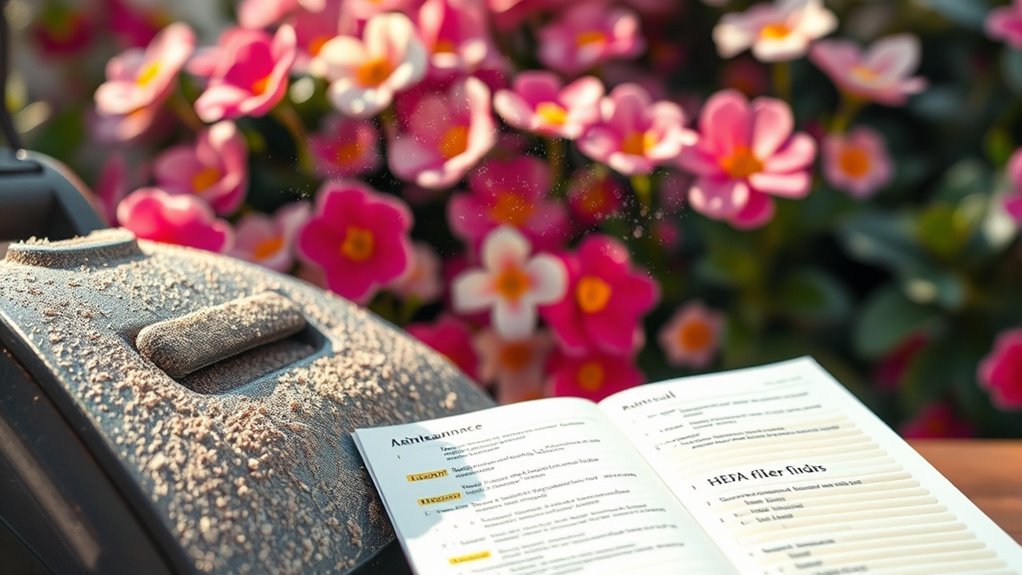
When it comes to vacuuming for allergies, several common issues can make your efforts counterproductive.
Many vacuum cleaners, especially older models, can release fine dust and allergens in your home back into the air, worsening your asthma symptoms. In fact, vacuums without HEPA filters can allow up to 50% of particles to escape during use. Regular maintenance of your vacuum cleaner is essential to ensure optimal performance, as a poorly maintained vacuum won’t effectively capture allergens. Additionally, using a vacuum with a high Clean Air Delivery Rate (CADR) can enhance your cleaning efforts and reduce allergens effectively. To maximize allergen removal, consider investing in a vacuum with advanced filtration systems that trap smaller particles efficiently.
Older vacuum cleaners can exacerbate asthma by releasing allergens back into the air, especially models without HEPA filters.
If you use a low-quality bagless vacuum, be cautious when emptying it, as this can create dust clouds that trigger allergic reactions. Regular use of air purifiers can help capture the allergens that vacuums may release back into the air.
The American Home Appliance Manufacturers recommends choosing vacuums with a clean air delivery rate (CADR) suitable for your home size to guarantee effective allergen removal. Additionally, consider the filtration systems of your vacuum, as those with advanced filters can significantly improve indoor air quality by trapping more allergens.
The Importance of HEPA Filters for Allergen Capture
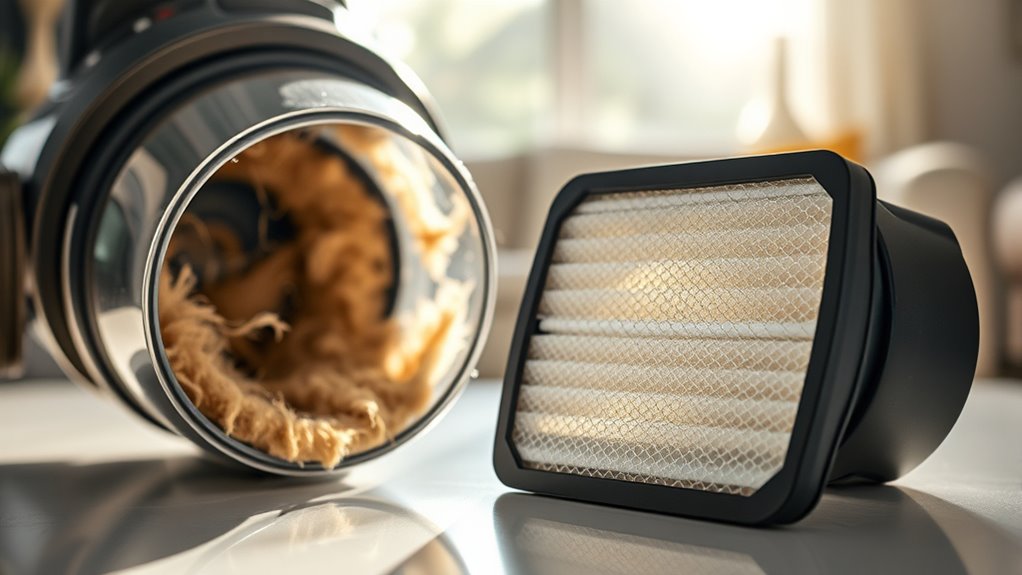
If you’re serious about reducing allergens in your home, investing in a vacuum with a HEPA filter is essential.
These filters capture 99.97% of particles as small as 0.3 microns, considerably improving your indoor air quality. Unlike standard vacuum cleaners, which can release fine dust back into the air, a HEPA-equipped vacuum actively traps allergens, preventing them from escaping.
Consider these benefits of HEPA filters:
- Captures dust mites and pet dander
- Reduces pollen and other airborne allergens
- Maintains cleaner air while vacuuming
- Enhances overall indoor air quality
- Requires regular maintenance for ideal performance
Additionally, using a vacuum with HEPA filtration ensures that you are effectively reducing allergens and improving the air quality in your home. Many air purifiers also utilize HEPA filter technology, providing a comprehensive approach to indoor air cleanliness. Moreover, using a vacuum that features user-friendly installation allows for easier maintenance and ensures optimal performance. Regular appliance maintenance can further enhance the effectiveness of your vacuum, ensuring it operates at peak efficiency.
Moreover, top-rated vacuums often come equipped with HEPA filters, making them a reliable choice for allergy sufferers. With a HEPA vacuum cleaner, you can breathe easier and enjoy a healthier living space.
Bagged vs. Bagless: Which Is Better for Allergies?
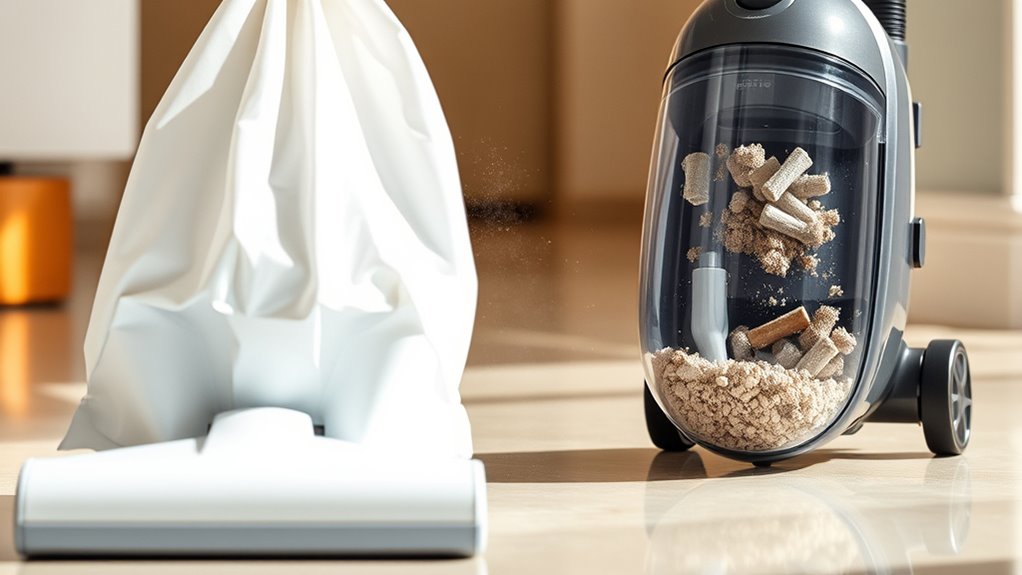
When choosing between bagged and bagless vacuums for allergies, you’ll want to contemplate how well each type contains dust and allergens.
Bagged models usually trap particles more effectively, while bagless options can release dust back into the air if not emptied carefully. Additionally, using a vacuum with a HEPA filter can significantly enhance allergen removal, making it a crucial feature to consider in your selection. Regular pet grooming can also help reduce the amount of hair and dander that your vacuum needs to handle. Furthermore, many top rated vacuums come equipped with advanced filtration systems that further aid in allergen capture. For instance, vacuums designed for pet hair removal often include features that enhance their allergen-containment capabilities. It’s also important to note that vacuums like the Dyson V11 are specifically engineered to maximize allergen filtration and improve air quality. Maintenance and costs also play a role, so it’s crucial to weigh these factors based on your cleaning habits and needs.
Dust Containment Efficiency
Choosing the right vacuum can make a significant difference in managing allergies, especially when comparing bagged and bagless models.
Bagged vacuums generally offer superior dust containment efficiency, effectively trapping allergens and minimizing your exposure during disposal. In fact, many HEPA filters used in bagged vacuums capture 99.97% of particles. The integration of advanced filtration systems in these vacuums further enhances their ability to reduce airborne allergens. Additionally, this technology is similar to how airless paint sprayers effectively prevent clogging and ensure smooth paint flow. Furthermore, functional layouts in your home can also play a role in minimizing dust accumulation.
Here are some key points to take into account:
- Bagged vacuums capture 99.97% of particles using HEPA filters.
- Sealed bags prevent allergens from escaping back into the air.
- Bagless models can release trapped dust when emptied.
- Regular maintenance is essential for both types to maintain performance.
- While bagged vacuums incur ongoing costs for replacement bags, their long-term allergen control benefits often outweigh these expenses. Additionally, seasonal promotions may help reduce the overall cost of purchasing a bagged vacuum.
Choosing a bagged vacuum could simplify your life and improve your allergy management.
Maintenance and Cost Considerations
Understanding the maintenance and cost considerations of bagged versus bagless vacuums helps you make an informed choice for managing your allergies. Bagged vacuums capture allergens effectively, minimizing your contact with dust during disposal. Although they require ongoing costs for replacement bags, this expense is often justified by their superior filtration capabilities. In contrast, bagless vacuums need regular maintenance to keep filters and bins clean, which can lead to allergen release if neglected. Additionally, regular maintenance is crucial to prevent performance issues similar to those seen in toilets with frequent running problems. Proper filter cleaning is essential for maintaining air quality and ensuring your vacuum remains effective in reducing allergens. Investing in eco-friendly toilets can also contribute to a healthier home environment by minimizing overall household water consumption.
| Aspect | Bagged Vacuums | Bagless Vacuums |
|---|---|---|
| Maintenance | Lower, less frequent | Higher, more frequent |
| Cost | Replacement bags needed | No bags, but filter costs |
| Filtration Capabilities | Superior | Generally less effective |
Choose wisely based on your allergy sensitivities!
Maintenance Tips to Enhance Your Vacuum’s Performance
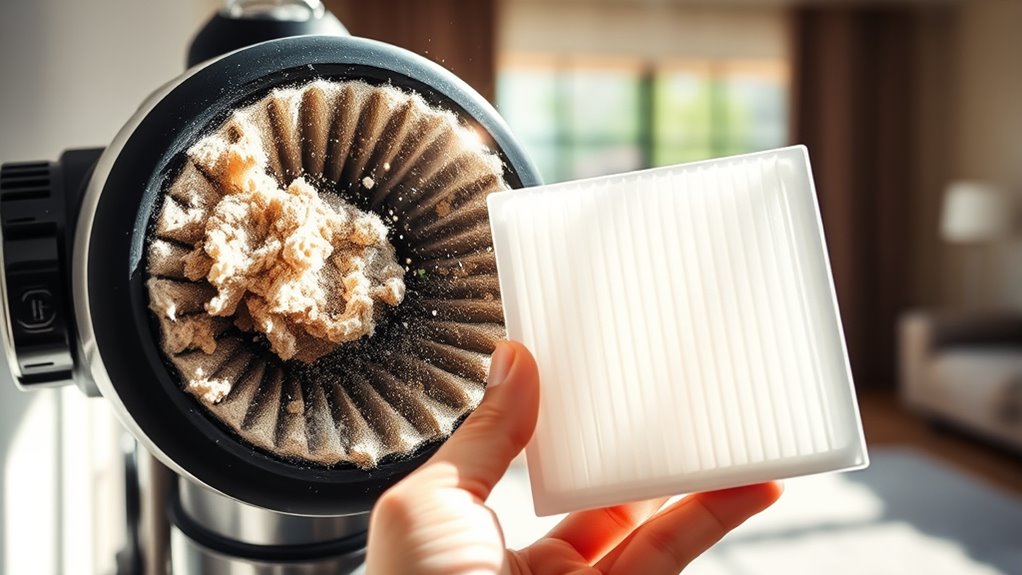
To keep your vacuum performing at its best, you should regularly replace the filters and maintain the brush.
A clean brush picks up allergens more effectively, while fresh filters guarantee ideal airflow.
Regular Filter Replacement
While you may not think about it often, regularly replacing your vacuum filters is essential for maintaining its performance and ensuring a healthier home environment.
Clogged or dirty vacuum filters can reduce suction power and let allergens escape back into the air. Here are some maintenance tips to keep in mind:
- Replace HEPA filters every 6-12 months for ideal allergen capture.
- Check and change vacuum bags or empty bins frequently.
- Clean or replace vacuum filters as recommended by the manufacturer.
- Use a vacuum cleaner with clean filters to effectively capture airborne particles.
- Monitor your vacuum’s performance to know when it needs filter updates.
Proper Brush Maintenance
Your vacuum’s brush bar plays an essential role in capturing allergens and maintaining clean air in your home. For ideal allergen capture effectiveness, follow these proper brush maintenance tips:
| Maintenance Task | Frequency | Purpose |
|---|---|---|
| Inspect and clean brush bar | Weekly | Prevent hair and debris buildup |
| Cut away tangles with scissors | As needed | Maintain brush performance |
| Check brush rotation | Before each use | Confirm no jams or stuck brushes |
| Adjust brush height | As needed | Match flooring type for better cleaning |
| Replace worn brushes | Every 6-12 months | Guarantee effective dust particle capture |
Choosing the Right Vacuum for Your Home Size and Needs
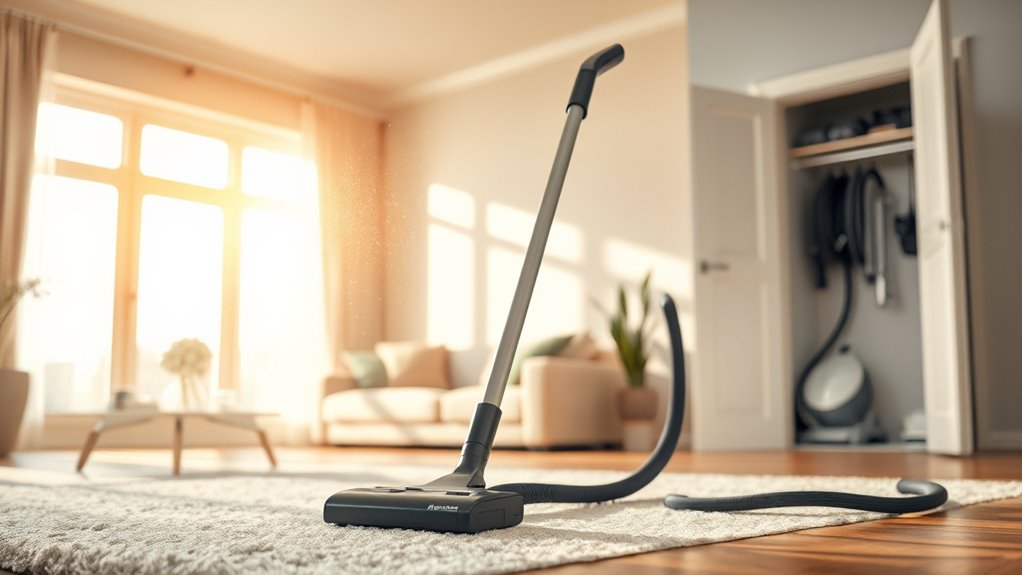
How do you choose the right vacuum for your home size and needs? Start by evaluating your space and specific requirements.
Consider the following factors when choosing a vacuum cleaner:
- Home Size: Larger homes may benefit from upright or canister models, while smaller spaces suit lightweight or handheld vacuums.
- Allergen Levels: Opt for vacuums with HEPA (high-efficiency particulate air) filters to capture dust and reduce airborne allergens, essential for asthma and allergy sufferers.
- Storage Space: Compact models are ideal for limited storage, while full-sized vacuums may offer better performance.
- Attachments: Look for vacuums with multiple tools for diverse cleaning needs.
- Maintenance: Regularly check and replace bags or filters to maintain suction and allergen capture effectiveness.
Choose wisely to enhance your home’s air quality!
Vacuuming Techniques to Minimize Dust and Allergens
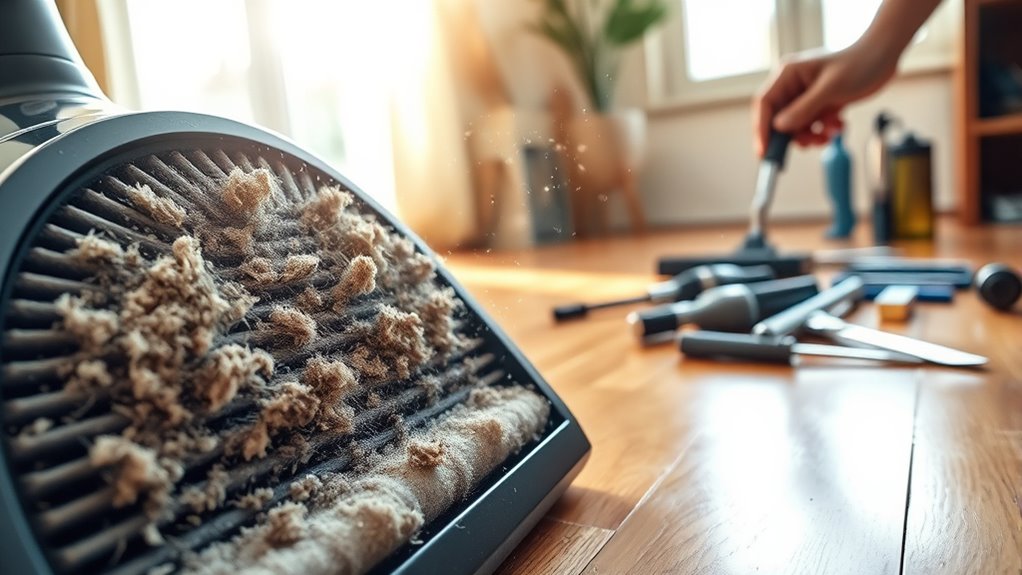
To effectively minimize dust and allergens while vacuuming, it’s essential to adopt the right techniques.
Start by vacuuming high surfaces first, allowing dust to fall where you’ll clean next. Use a vacuum equipped with a HEPA filter, which captures 99.97% of particles, including allergens like dust mites.
Move slowly and deliberately, letting the vacuum thoroughly extract dust from carpets and upholstery; pass over each area multiple times for the best results.
Don’t forget specialized attachments like crevice tools and upholstery brushes to reach those hard-to-clean spots.
Finally, stick to a regular vacuuming schedule—at least once a week for carpets and twice a week for high-traffic areas—to keep allergens at bay and improve your indoor air quality.
How Often Should You Vacuum for Optimal Allergen Control?
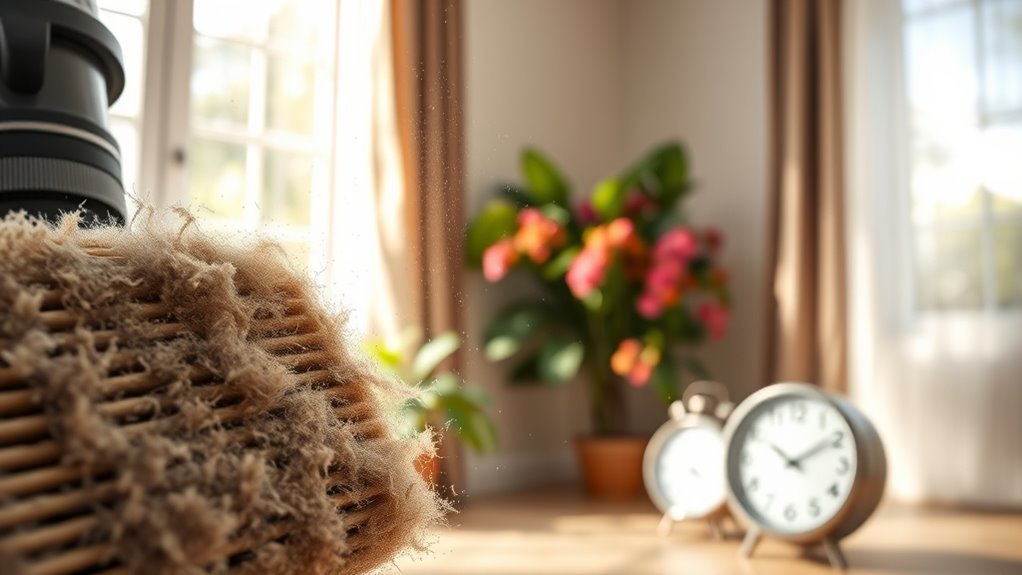
When should you vacuum for the best control of allergens in your home? To effectively manage allergens like pet dander and dust, follow these guidelines:
- Vacuum carpets at least once a week, and high-traffic areas twice a week.
- In homes with pets, vacuum upholstered furniture, mattresses, and drapes at least twice a week.
- Use a vacuum with a HEPA (high-efficiency particulate) filter to capture more allergens.
- Vacuum slowly and methodically to prevent stirring up dust into the air.
- Increase vacuuming frequency during allergy seasons or after events like parties.
The Role of Air Quality in Allergy Management
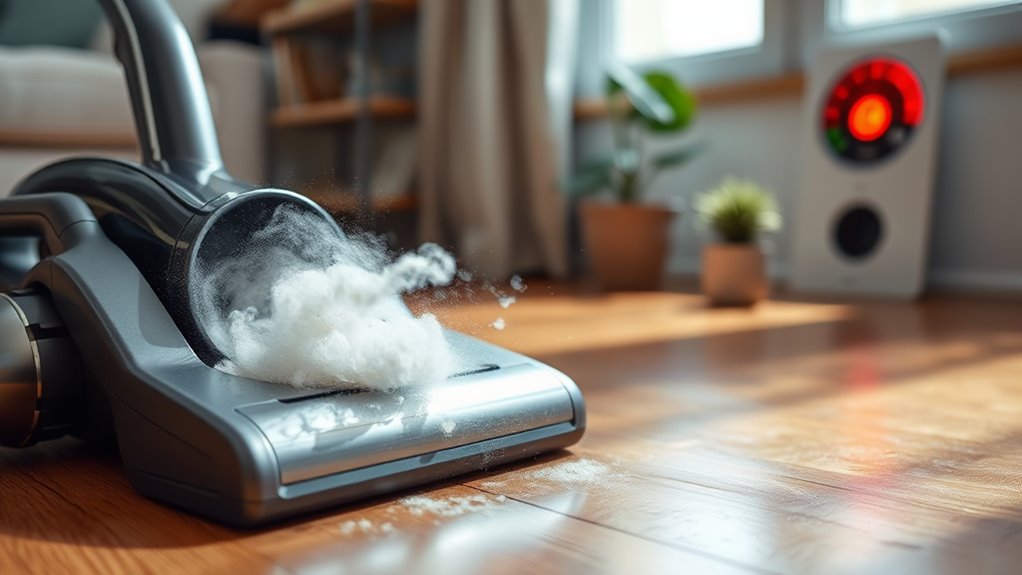
Vacuuming regularly is just one piece of the puzzle when it comes to managing allergies effectively.
To improve air quality, focus on reducing airborne allergens like dust mites, pet dander, and mold. The American Academy of Allergy, Asthma & Immunology suggests changing air filters every 3-6 months to maintain ideal air quality.
To enhance air quality, target airborne allergens and change air filters every 3-6 months for optimal results.
Consider using portable air purifiers with high-efficiency particulate air (HEPA) filters to trap allergens and enhance your environment.
It’s also essential to keep indoor humidity below 50% to prevent mold growth, which can worsen symptoms.
Integrating effective cleaning solutions, such as damp dusting alongside your vacuuming routine, will further minimize allergens, making your home a more comfortable space for allergy sufferers.
Additional Cleaning Tools to Complement Your Vacuum
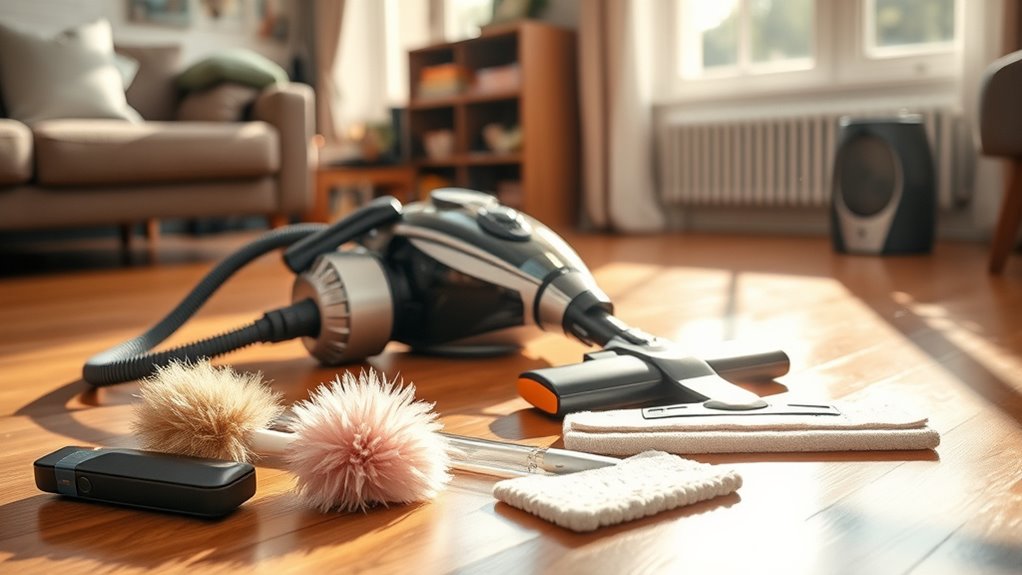
While vacuuming is essential for allergy management, utilizing additional cleaning tools can enhance your efforts considerably.
Here are some tools you can use to complement your vacuum:
- Electrostatic or microfiber dust cloths to trap dust and allergens in hard-to-reach areas.
- A damp mop for hard floors, capturing fine particles and allergens that vacuums might leave behind.
- Handheld vacuum attachments for quick clean-ups on upholstery and stairs.
- Air purifiers with HEPA filters that continuously filter airborne allergens, improving indoor air quality.
- Regularly washed throw rugs and washable curtains to manage allergen levels and kill dust mites.
Frequently Asked Questions
What Type of Vacuum Is Best for Allergies?
If you’re looking for the best vacuum for allergies, consider models with HEPA filters.
These filters capture 99.97% of tiny particles, effectively trapping allergens.
Bagged vacuums are often more effective than bagless ones, as they contain dust better during disposal.
Central vacuum systems and water vacuums also excel at allergen removal, minimizing airborne particles.
Regular maintenance, like checking filters and bags, is essential to keep your vacuum working effectively against allergens.
How Can I Improve the Suction on My Vacuum?
Ever tried vacuuming with a straw? Yeah, it doesn’t work!
To improve your vacuum’s suction, regularly check and replace the bags or empty the bins. Clean the brush bar and filters to guarantee nothing’s blocking airflow.
Clear any clogs in the hose, and adjust settings for different surfaces to maximize contact. Investing in a vacuum with a HEPA filter can also enhance suction and capture those pesky allergens more effectively.
How to Vacuum When You Have Allergies?
When you’ve got allergies, vacuuming effectively is vital. Start by working from the highest surfaces down to avoid stirring up dust.
Use a vacuum with a HEPA filter to trap allergens. Confirm you vacuum carpets and upholstery at least twice a week, especially in high-traffic areas.
Move slowly to enhance suction, and always check your vacuum for maintenance. Keeping it clean guarantees it doesn’t release trapped allergens back into your space.
Why Does Vacuuming Make My Allergies Worse?
When you vacuum, it might feel like you’re stirring up a hornet’s nest.
Many vacuums, especially older models, actually release dust and allergens back into the air instead of capturing them. This can trigger your allergies and worsen your symptoms.
If your vacuum lacks a HEPA filter, it’s likely not trapping fine particles effectively, leaving you exposed to irritants.
Conclusion
To summarize, improving your vacuum can make a significant difference for allergy sufferers. Did you know that nearly 50 million Americans experience allergies each year? By opting for a vacuum with a HEPA filter, maintaining it regularly, and using effective techniques, you can drastically reduce allergens in your home. Remember, a cleaner space leads to better air quality and a more comfortable living environment. Don’t underestimate the power of a well-chosen vacuum in your allergy management strategy!


